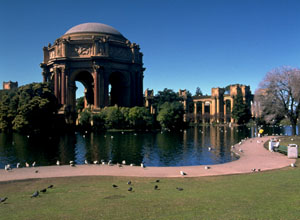
Housed in the Palace of Fine Arts from the 1916 Pan Pacific Exhibition World Fair.
currently processing new images.
The Exploratorium
The Exploratorium

Housed in the Palace of Fine Arts from the 1916 Pan Pacific
Exhibition World Fair.
by Paul Doherty
The Exploratorium was founded in 1969 by physicist and teacher Frank Oppenheimer.(The brother of J. Robert Oppenheimer.)
Frank Oppenheimer
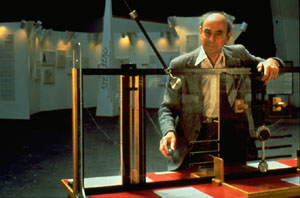
Frank visited Museums all over the World then searched for a building. He found the Palace of Fine Arts, built for the World's Fair of 1916, the Pan Pacific Exhibition by Bernard Maybeck.
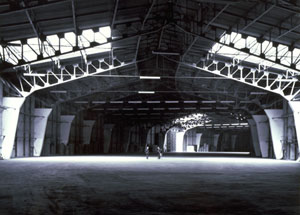
The Palace of Fine Arts in 1969, future home of the
Exploratorium.
Inside the Palace was one giant room, 100,000 square feet, or 10,000 square meters.
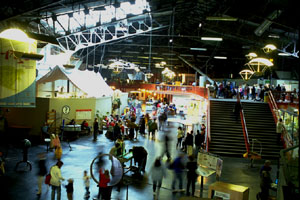
Inside the Exploratorium, one giant room with 500 exhibits.
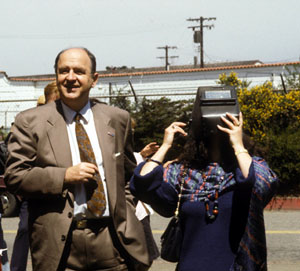
Goery Delacote has been the director of the Exploratorium since
1991.
Here he helps a visitor watch a partial solar eclipse.
We say we are a museum of Science, Art and Human Perception.
We create more new hands-on science explorations than any other museum in the world, about one new exhibit every week.
We have exhibits for everyone from children to adults including teenagers and physics professors (both tough audiences.)
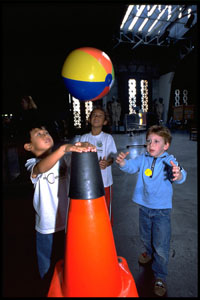
Children play with a ball suspended over a blower.
Former President Bill Clinton asked for this exhibit to use during
his inaugural party for children.
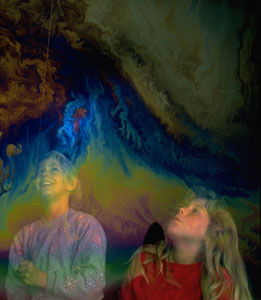
Children admire the interference colors at the Soap Film Painting
Exhibit.
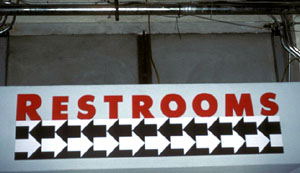
This restroom sign is a perception exhibit.
All of our exhibits are built in the machine shop inside the Exploratorium.
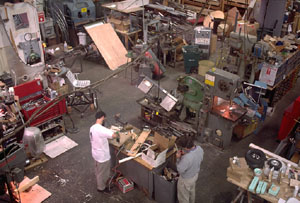
The creative chaos of the machine shop.
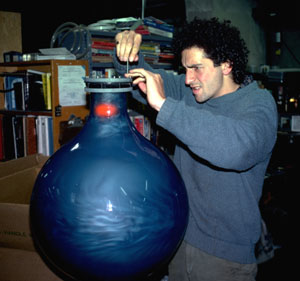
Exhibits are created by artist/scientist/engineer teams.
Here Ned Kahn puts the finishing touches on a Turbulent
Orb.
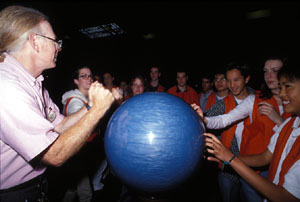
Paul Doherty teachers the teenage floor staff of the museum about the
science of the exhibits.
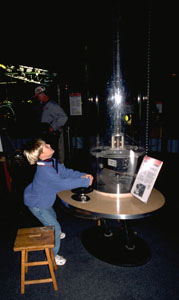
This giant Jacob's Ladder makes a spark which the visitor can blow up
or down by turning a crank. One day the exhibit caught fire and
visitors enjoyed fanning the flames with the blower thinking that
this was what the exhibit was supposed to do.
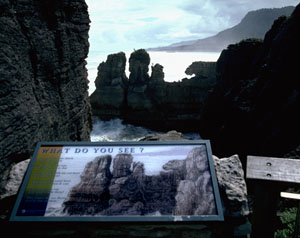
I always start my lessons by asking visitors "What do you see?"
It's a question they cannot get wrong.
We also have programs for high school science teachers.
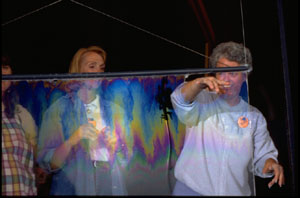
Teachers begin at exhibits.
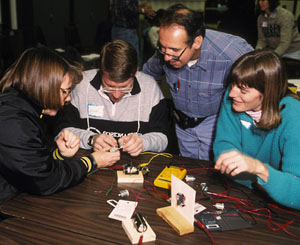
Teachers then go into the classroom to build there own exhibits, here
ammeters.
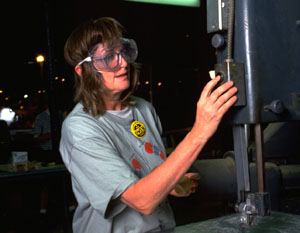
Teachers can also work in the machine shop building exhibits to take
back to their schools.
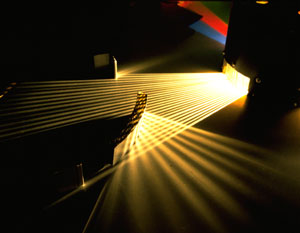
The light island Exhibit can be used to study optics. Here it traces
rays to show the location of a virtual image in a convex mirror.
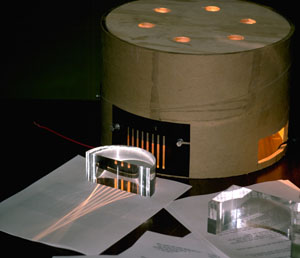
Here is a classroom version of the light island exhibit made with
cardboard concrete forms.
We feature a web competition for science teachers named
Iron Science Teacher.
The teachers are given an ingredient like "candy bars" and have 10 minuttes to create a science lesson using that material. These competitions are browdcast on the Web. they are archived at
http://www.exploratorium.edu/iron_science/
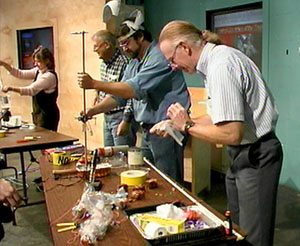
We also take our science teaching out into the world. Here is Paul Doherty teaching chhildren in Zambia about the earth and the moon to prepare them for an eclipse.
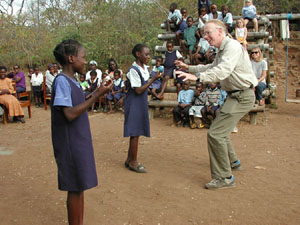
Paul Doherty at Tujatane School near Livingston Zambia.
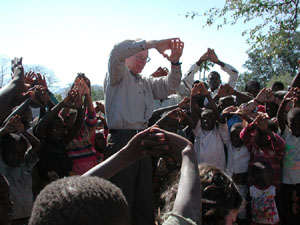
Paul Doherty teaching a lesson on how to safely view a solar eclipse
during the partial phases at a village along the Zambezi River in
Zambia.
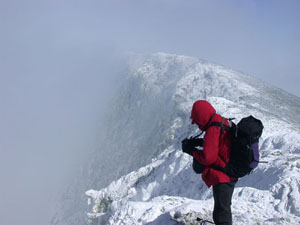
Paul Doherty about to do a webcast from the summit rim of Mt. EErebus
in Antarctica.
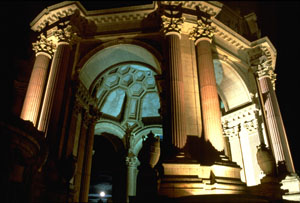
But when the day is over we like to return to the Exploratorium.
Science Topics
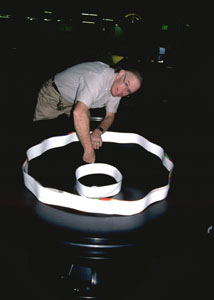
The gravity well also models the electrical potential energy of a
hydrgen atom.
Circles of paper can be used to show standing waves in the Bohr model
of the atom.
The inner ring has 1 wave the outer ring has 4 waves.
Here's a puzzle.
This giant lens remains the same diistance from a trash container.
Classic physics shows that at one distance for an object a lens produces either a real or a virtual image.
Yet as I walk toward this lens the image of the trash container switches from real to virtual.
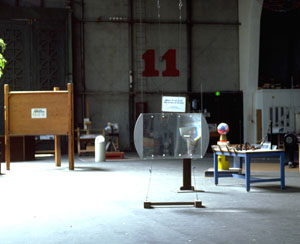
An inverted real image
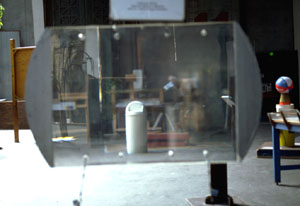
A virtual image.
The Pendulum Snake
The exhibit builder wanted to know how to make the pendulums so that each pendulum made exactly one moore swing than its neighbor in 30 seconds.
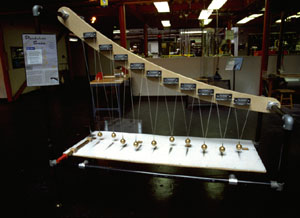
When all the pendulums start together they all drift out of phase until at 30 seconds they all return to perfect alignment.
A rod angled at 45 degrees and rotated through a plane fits through a hyperbolic slot.
Proving this is an interesting problem in geometry.
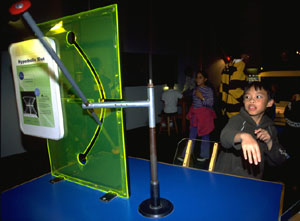
Mercator Your Face.
At this exhibit we teach about Mercator projections by making a Mercator projection of the visitors face.
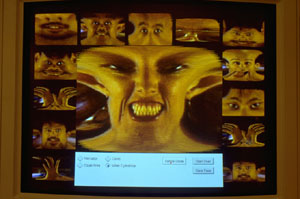
String squirter
This exhibit shoots a string into the air. Nobel prize winner Leon Ledderman worked with uus to figure out the shape of the string.
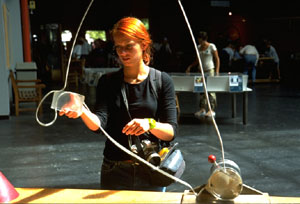
We have an exhibit tthat projects a poisson spot.
A bright point of light apppears in the middle of the shadow of a solid ball bearing.
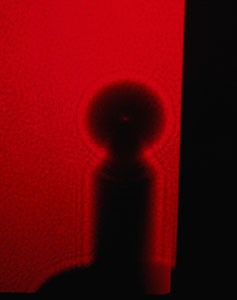
The museum also works with artists. Bill Parker made the first lightning ball at the Exploratorium.
The glowing electron paths narrow due to magnetic focussing as the current is increased.
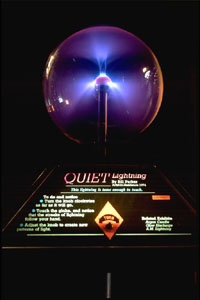
A Xylophone is tuned to the resonances of a tall cement room.
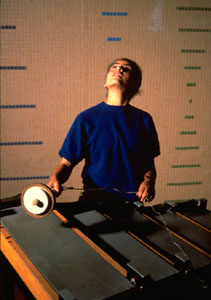
At one height in the room there is no perceived sound.
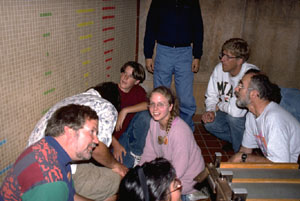
The no-sound point is noot at the node of motion at the floor. It is at the antinode above the floor. The human ear is a pressure change sensor not an air motion sensor.
Sometimes visitors teach uus what exhibits are about. This exhibit started out rolling balls on a spinning mmetal disk. But visitors showed us that the motion of coins was much more iinteresting, so now we provide thhem with disks.
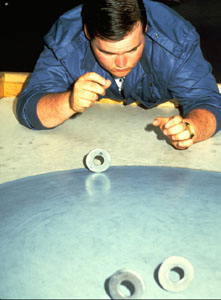
|
Scientific Explorations with Paul Doherty |
|
23 March 2004 |